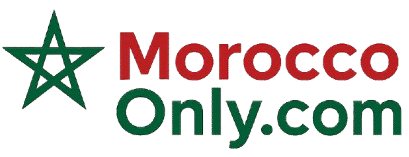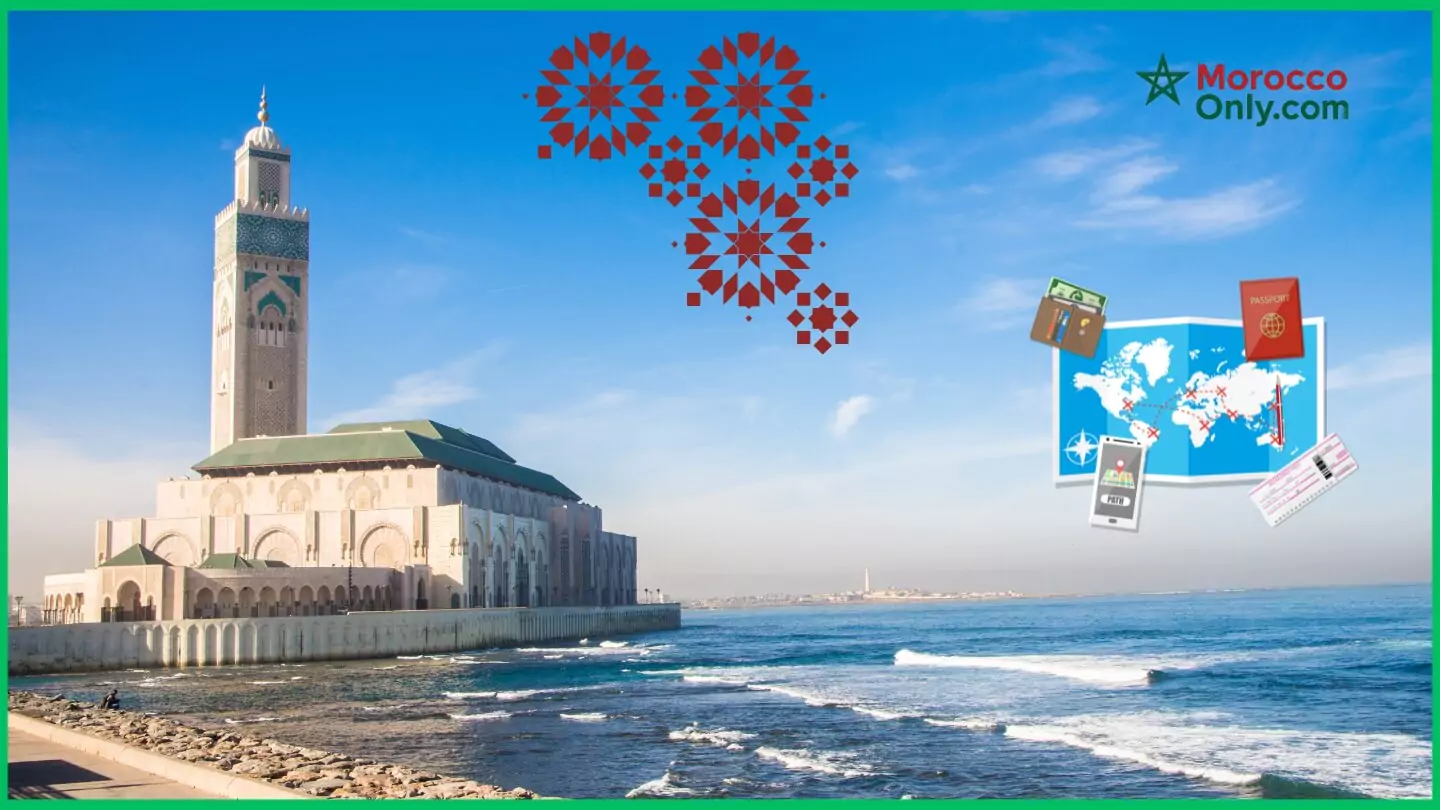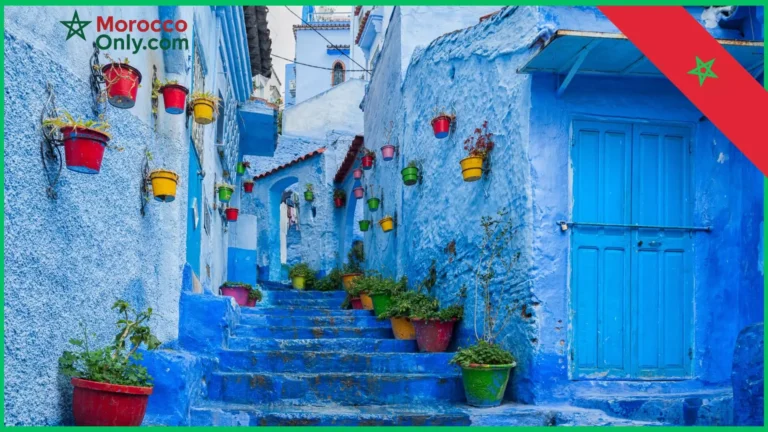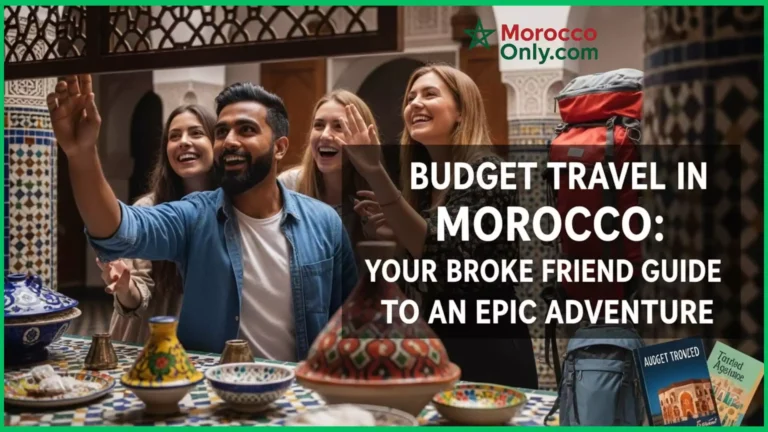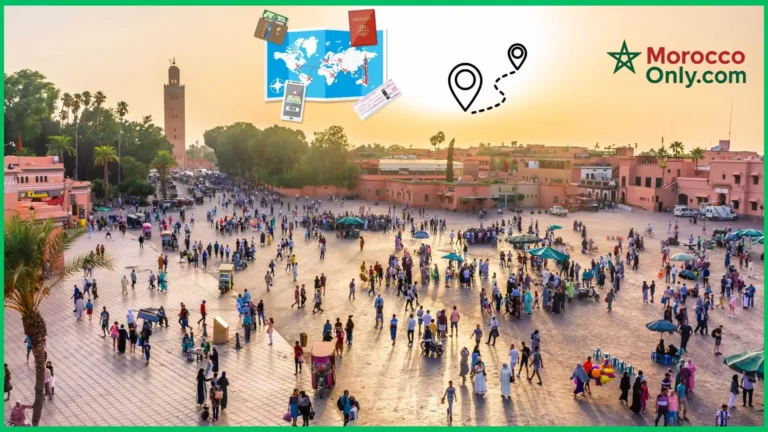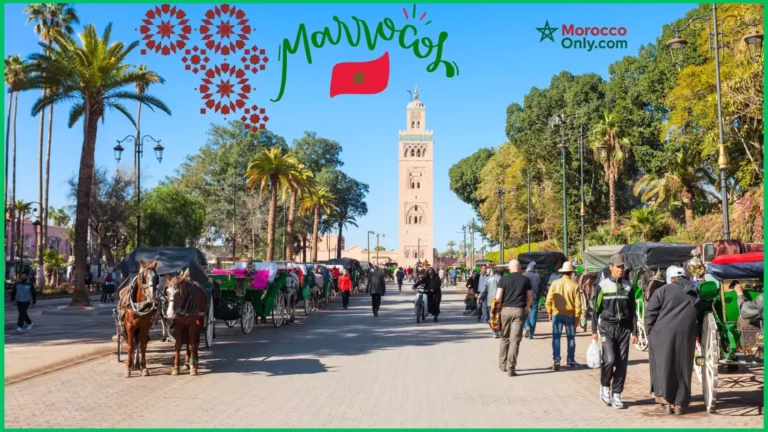How to Spend a Perfect Weekend in Morocco
So you’re thinking about Morocco for a weekend trip? Trust me, it’s one of those places that’ll completely blow your mind in just 48 hours. I’m talking about a country that feels like you’ve stepped into a whole different world – and the best part? You don’t need to fly halfway around the globe to get there (well, unless you’re already halfway around the globe, but you get what I mean).
Let me tell you, believe it or not, Morocco is very accessible for a quick little trip. If you live in Europe, the flight will probably be 3-4 hours max. From everywhere else, it is still relatively convenient for a weekend escape. Also, Morocco is really cheap! You will stretch your money much farther compared to many other exotic locations. You can sleep in luxury riads, eat great food, and participate in unique experiences without completely emptying your account.
What makes Morocco perfect for a short trip is that you can pack an insane amount of experiences into just a couple of days. One minute you’re haggling for spices in a thousand-year-old market, the next you’re sipping mint tea on a rooftop overlooking the Atlas Mountains. It’s like the country was designed for people with short attention spans and packed schedules (aka all of us).
Choosing Your Destination: Best Cities for a Short Trip
Marrakech – The Vibrant Red City
Let’s start with the obvious choice – Marrakech. This place is basically Morocco’s greatest hits album. Everything you’ve seen in movies or on Instagram? Yeah, it’s probably from here. The whole city is painted in this gorgeous red color that looks absolutely magical against the snow-capped mountains in the background (yes, Morocco has snow – who knew?).
The main square, Jemaa el-Fnaa, is where the magic happens. During the day, it’s pretty chill, but as the sun goes down, it transforms into this crazy carnival with snake charmers, drummers, and food stalls everywhere. Fair warning though – it can be a bit overwhelming if you’re not ready for the sensory overload. But honestly? That’s part of the charm.
The souks (that’s what they call the markets) are absolutely insane in the best way possible. You’ll get lost – and I mean really lost – in these narrow alleyways packed with everything from gorgeous rugs to leather goods that smell like… well, let’s just say the tanneries are nearby. Pro tip: getting lost is actually fun here, so just go with it.
When you need a break from all the chaos, hit up the Majorelle Garden. It’s this stunning blue oasis that’ll make your Instagram followers super jealous. The Bahia Palace is also worth checking out if you want to see how the other half lived back in the day.
Fes – Morocco’s Cultural Capital
If Marrakech is the party city, Fes is the intellectual older sibling. This place is all about history and culture – we’re talking about a city that’s been around for over 1,000 years. The medina here is supposedly the largest car-free zone in the world, which means you’ll be doing a lot of walking on ancient cobblestones (comfortable shoes, people!).
The famous tanneries are both fascinating and, um, aromatic. They’ll give you a sprig of mint to hold under your nose because trust me, you’ll need it. But watching these guys work leather the same way they’ve been doing it for centuries is pretty incredible.
Fes has this really interesting scholarly feel to it. The University of Al-Qarawiyyin (which is apparently the oldest university in the world?) feels intense in a good way; you can feel the history in that place. It’s just a bit less touristy than Marrakeck, which evidently some people prefer (if you are not into snake charmers, for example).
Casablanca – Urban Chic Meets Tradition
Casablanca is totally different from the other two. It’s got this cool French colonial vibe mixed with modern Morocco. Think wide boulevards, art deco buildings, and way more of a cosmopolitan feel. The Hassan II Mosque is absolutely massive and sits right on the ocean – it’s pretty spectacular even if you’re not usually into architecture.
The nightlife here is way more relaxed than in other Moroccan cities, so if you want to grab a drink after dinner, this is your spot. The city also has some seriously good restaurants that mix French techniques with Moroccan flavors. It’s like fancy fusion food before fusion food was cool.
Shopping here ranges from traditional markets to actual malls, so if you need a break from haggling, you can hit up some air-conditioned retail therapy.
Chefchaouen – The Blue Pearl
Okay, this place is basically Instagram heaven. The entire town is painted in these gorgeous blue shades that look absolutely stunning against the mountains. It’s like someone took a paintbrush to a whole city and decided blue was the way to go.
The vibe here is super chill – way more relaxed than the bigger cities. You can actually walk around without someone trying to sell you something every five seconds (though they’ll still try, just less aggressively). The hiking around here is supposed to be amazing if you’re into that sort of thing.
Fair warning: it’s become pretty touristy because of the whole Instagram thing, but honestly, it’s still worth it. Just maybe don’t expect to be the only person taking photos of those blue walls.
Day 1 Itinerary: Dive into the Moroccan Experience
Start with a Traditional Moroccan Breakfast
Forget your usual coffee and croissant routine – Moroccan breakfast is a whole different game. We’re talking fresh bread (and I mean FRESH – like still warm from the oven), honey, olives, and this amazing stuff called amlou, which is basically like Moroccan peanut butter but way better.
The best spot to try this is in one of those traditional cafes in the medina. They’re usually tucked away in these gorgeous old buildings with amazing tile work. Or if your riad has a rooftop terrace, even better – breakfast with a view of the Atlas Mountains? Yes, please.
And then there’s the mint tea. Oh man, the mint tea. It’s not just a drink here – it’s basically a cultural experience. They’ll serve it in these tiny glasses, and it’s the perfect way to ease into your Moroccan adventure. Just don’t expect regular coffee to taste the same after this trip.
Explore the Medina and Local Markets
This is where things get real. The medina is like stepping back in time, except with more people trying to sell you stuff. The souks are organized by what they sell – leather goods here, spices there, textiles over there. It’s actually pretty smart once you figure out the system.
Now, about the haggling – don’t stress about it too much. Yeah, you’re probably gonna pay more than locals, but that’s just how it works. Start at about a third of what they’re asking and work your way up. The whole thing is like a game, and honestly, the shopkeepers seem to enjoy it as much as you do (or at least they pretend to).
The spice section is incredible. You’ll find saffron, all these crazy spice blends, and preserved lemons that’ll make your taste buds dance. Fair warning though – you’ll want to buy everything, and then you’ll get home and realize you have no idea what to do with half of it.
Visit Key Historical and Cultural Sites
Time for some culture! The Bahia Palace is absolutely gorgeous – all intricate tile work and peaceful courtyards. It’s one of those places that makes you wonder how people lived so beautifully back in the day.
The Koutoubia Mosque has this iconic minaret that you’ll recognize from every Marrakech postcard ever. You can’t go inside if you’re not Muslim, but the gardens around it are lovely, and it’s a great landmark for getting your bearings.
In Fes, definitely check out the Bou Inania Madrasa. The detail work is absolutely insane – like, how did they even do that with the tools they had back then? It’s one of those places that makes you feel like you’re in a movie.
End Your Day with a Hammam and Rooftop Dinner
the hammam experience is… intense. It’s basically a traditional steam bath where they scrub you down with what feels like sandpaper (but in a good way?). It’s definitely a cultural experience, and you’ll feel amazingly clean afterward. Just maybe don’t do it on your first day if you’re not ready for the full cultural immersion.
For dinner, locate a rooftop restaurant with a view. There is something special about eating tagine while watching the sun set over the medina. Many places have traditional musicians performing, which heightens the experience. Be ready for the call to prayer, which is lovely, but might catch you off guard if you’re not expecting it!
Day 2 Itinerary: Adventure and Serenity
Go for a Morning Desert or Mountain Excursion
Day two is adventure time! Even on a weekend trip, you can get a taste of Morocco’s incredible landscapes. The Atlas Mountains are absolutely stunning, and you can visit traditional Berber villages where life hasn’t changed much in centuries.
The mountain trips usually include lunch with a local family, which is an amazing experience. The hospitality is incredible – they’ll feed you until you can’t move and treat you like family. Just be prepared for some winding mountain roads if you get carsick easily.
If you’re more of a desert person, there are day trips to places like the Agafay Desert. It’s not the full Sahara experience, but you’ll get the sandy landscapes and maybe some camel action without the crazy long drive.
Try Camel Rides or Quad Biking
Camel riding is one of those things you have to do at least once, right? These animals are surprisingly comfortable to ride once you get the hang of it. They’re also way more chill than you’d expect – like the golden retrievers of the desert world.
If you’re more of an adrenaline junkie, quad biking is super fun. You can cover way more ground and get to some really cool spots. Most places will give you a helmet and basic training, so don’t worry if you’ve never done it before.
Both activities usually end with a traditional meal in some gorgeous setting – maybe a desert camp or a mountain village. It’s the perfect way to combine adventure with cultural experiences.
Enjoy a Slow, Traditional Moroccan Lunch
Moroccan lunch is not a quick grab-and-go situation. This is a whole event. They bring out multiple dishes family-style, and you eat with your hands using bread as utensils. It’s actually way more fun than it sounds.
Tagine is obviously the star of the show. If you’ve never had real tagine (and no, the stuff at that Moroccan restaurant back home doesn’t count), you’re in for a treat. The slow cooking makes everything incredibly flavorful. Try the chicken with preserved lemons – it’s like a flavor explosion in your mouth.
Couscous is another must-try, especially if you’re there on a Friday when it’s traditional family meal time. Watching them prepare it is almost as good as eating it – they steam it multiple times to get the perfect fluffy texture.
Wind Down with Museums and Sunset Views
After all that adventure, you’ll probably want to slow down a bit. Morocco has some really cool museums that give you insight into the country’s history and art. The Dar Si Said Museum has amazing collections of traditional crafts, and the building itself is gorgeous.
The Majorelle Garden Museum is perfect if you want to combine art with some peaceful garden time. The whole place is painted in this incredible blue color that photographs beautifully (yeah, I’m talking to you, Instagram addicts).
As the day winds down, find a good spot for sunset. Whether it’s a rooftop terrace overlooking the medina or a mountain viewpoint, Morocco does sunsets right. Grab a mint tea and just soak it all in.
Where to Stay: Best Riads and Hotels in Morocco
What is a Riad?
So, a riad is basically a traditional Moroccan house built around a central courtyard. Think of it as the opposite of a regular hotel – instead of facing outward, everything faces inward to this gorgeous courtyard with fountains, orange trees, and usually some incredible tile work.
The whole design is genius for keeping things cool in the hot climate. Plus, it shuts out all the noise from the crazy medina streets. Most riads have been converted into guesthouses, and staying in one is like living in a piece of Moroccan history.
The best part? They’re usually pretty intimate, so you get personalized service and insider tips from the staff. Many of them have rooftop terraces where you can have breakfast with amazing views or just chill with a book.
Top Riads in Marrakech and Fes
In Marrakech, you’ve got options for every budget. If you want to go all out, places like Riad Farnatchi are absolutely incredible – like staying in a palace. For something more budget-friendly, Riad Dar Anika gives you the authentic experience without breaking the bank.
La Mamounia is technically a hotel, but it’s so legendary that it deserves a mention. We’re talking old-school glamour where celebrities and royalty have stayed. It’s pricey, but if you want to splurge, this is the place.
Fes has some amazing riads too, many in buildings that are seriously old. Riad Fes Maya is gorgeous and perfectly located in the medina. For luxury, Palais Faraj is like staying in an actual palace with incredible views of the ancient city.
Best Hotels in Casablanca and Chefchaouen
Casablanca is a hotel city, not a riad city. The Four Seasons is a luxury brand with oceanviews and every amenity. Villa Blanca Sidi Bousaid is a cooler option – it has a colonial charm with modern convenience.
Chefchaouen is small, so your options are more limited but often more personal. Casa Hassan is this charming place with amazing mountain views from the rooftop. Most places here are family-run, which means you’ll get that personal touch you can’t find in big hotels.
Moroccan Cuisine: A Flavorful Weekend Journey
Must-Try Dishes
Let’s talk about the food – because honestly, this might be the best part of your whole trip. Tagine is obviously the star, but there are so many varieties. The chicken with preserved lemons and olives is, in a sense, comfort food, but exotic comfort food. The lamb with apricots is like the perfect sweet-savory combo to make you question why we don’t put fruit in everything.
Couscous is far more complicated than you’d expect. They steam it multiple times to create the right fluffy texture, and the vegetable stew that accompanies it is amazing. The seven-vegetable version is like tasting a rainbow of flavors.
Harira soup is this hearty tomato-based soup that’s perfect comfort food. It’s especially big during Ramadan, but honestly, it’s good any time. And b’stilla – okay, this one’s weird but amazing. It’s like a sweet and savory pastry with meat and almonds and cinnamon. Trust me on this one.
Best Places to Eat
Street food is where it’s at for authentic, cheap eats. The night market in Jemaa el-Fnaa looks chaotic, but the food is incredible. Just follow the locals – they know what’s good.
For something more upscale, find a restaurant in a converted riad. The atmosphere is amazing, and the food is usually top-notch. Many places offer set menus that let you try a bunch of different dishes, which is perfect for indecisive people like me.
Rooftop restaurants are perfect for special occasions. The views are incredible, and many have live music. Just be prepared to pay a bit more for the atmosphere.
Don’t Miss the Mint Tea Experience
Mint tea isn’t just a drink here – it’s like a whole cultural thing. They prepare it with this elaborate ritual, pouring it from way up high to create foam. It’s actually pretty impressive to watch.
The tea culture is serious business. Refusing tea can be considered rude, so just go with it. The first glass is strongest, second is most balanced, third is sweetest. It’s like a journey in three acts.
You’ll find yourself drinking tea constantly – with meals, during shopping, when meeting people. It’s basically the social lubricant of Morocco, and honestly, it’s delicious enough that you won’t mind.
Navigating Morocco: Transportation Tips for a Smooth Weekend
Airport Transfers and Getting Into Town
Getting from the airport to your hotel is pretty straightforward. In Casablanca, there’s actually a train from the airport, which is super convenient and cheap. For other cities, you’ve got official airport taxis with fixed prices – no haggling required.
If you are staying in a riad in the medina, be sure to have your accommodation arrange for a pickup. It’s far too difficult to find these places on your own, and taxi drivers can’t get too close anyway.
Pre-arranged transfers are worth it if you want to avoid any stress. Yeah, they cost more, but when you land tired and jet-lagged, having someone waiting with your name on a sign is pretty nice.
Getting Around Between Cities
The train system is actually pretty good for getting between major cities. It’s comfortable, reliable, and you get to see the countryside. First class is worth it for the AC and reserved seats, especially in summer.
For places the train doesn’t go (like Chefchaouen), buses are your best bet. CTM buses are modern and comfortable – way better than you might expect. Just book in advance during busy times.
Car rentals provide the most flexibility, but driving in Morocco is… an adventure. If you’re not confident in aggressive driving and creative interpretation of the rules of the road, it might be worth sticking with trains and busses.
Local Transportation in the City
Petit taxis are found everywhere, and they are affordable. They are supposed to use their meters, however, drivers may try to negotiate a flat rate, especially with tourists. Using a meter will usually end up being cheaper, so ask for the meter and stick with it.
Walking is honestly the best way to explore the medinas. Yeah, you’ll get lost, but that’s half the fun. The narrow streets and hidden corners are what make these places special.
Guided tours can be worth it if you’re short on time. A good guide will show you things you’d never find on your own and help you navigate the chaos.
Budgeting Your Weekend: Costs and Money Tips
Typical Daily Expenses
Morocco is seriously affordable, which is part of why it’s so great for weekend trips. Budget travelers can get by on $30-50 a day, mid-range folks usually spend $75-150, and if you want to go luxury, you can easily spend $200-500+.
Food is where you can really save money. Street food and local restaurants are crazy cheap and often better than expensive touristy places. A good meal at a local spot might cost $5-15, while fancy places are $25-50.
Accommodation varies wildly. You can find decent hostels for $15-30 a night, nice riads for $50-100, or luxury places for $200-500+. Transportation is generally cheap – city taxis are usually under $10, and intercity buses/trains are $5-25.
Currency Exchange and Tipping Etiquette
The currency is the dirham, and you’ll want to have cash for most things. ATMs are everywhere and usually give good rates. Credit cards work at nice hotels and restaurants, but bring cash for markets and smaller places.
Tipping is expected but not crazy expensive. Restaurants get 10-15%, hotel staff get a few dollars for services, and taxi drivers appreciate you rounding up. Tour guides usually get $5-20 depending on the length and quality of the tour.
Keep small bills handy for tips and small purchases. Change can be hard to come by, and nobody likes the awkward “do you have change for a 200 dirham note for this 10 dirham item” situation.
Packing Tips for a Moroccan Weekend
What to Wear for Comfort and Culture
Morocco is relatively conservative, so you’ll want to dress modestly, especially in areas where there may be religious sites. When dressing modestly, you’ll need to cover shoulders and knees, but don’t get too worried—you don’t have to look like a nun! Light and loose clothing is perfect culturally and it is ideal for climate as well.
You definitely need suitable footwear, you will be doing a lot of walking on cobblestones and uneven walking surfaces. Sandals can be fine for casual wear (and definitely OK for beach wear, etc.), but if you are intending to visit tanneries, leather shoes are a great choice to avoid (trust me).
Dress in layers because temperatures can differ greatly. Days in the desert are hot, but nights can get cool, even in the desert. Depending on the time of year and elevation, mountain areas can be downright cold. A light jacket or a sweater is always a good option.
Must-Pack Essentials
Bring a good first-aid kit with stomach medicine – your digestive system might need some time to adjust to the local cuisine. High SPF sunscreen is a must year-round because the sun here doesn’t mess around.
Power adapters for Type C and Type E outlets are essential. Bring a portable charger too because you’ll be taking a million photos and your phone battery will hate you.
Hand sanitizer and wet wipes are lifesavers. Also pack modest clothing for mosque visits and any prescription medications in original containers. A small daypack is perfect for carrying water, snacks, and souvenirs while exploring.
Cultural Etiquette and Safety Tips
Dos and Don’ts in Moroccan Society
While Moroccans are very welcoming, there are somethings to keep in mind for culture. Always eat and greet using your right hand, as the left hand is considered unclean. Never wear shoes into a home or mosque.
Don’t point the bottom of your feet at people when sitting, and avoid public displays of affection. It’s also polite to ask before photographing people, especially women.
Learning a few basic Arabic or French phrases goes a long way. Even just “shukran” (thank you) and “salam” (hello) will earn you smiles and better service.
Safety for Solo and Female Travelers
Morocco is mostly safe, but be sensible. Watch your possessions and your surroundings. The medinas can be confusing to navigate so keep a map handy, or download the hotel location to your phone.
Female travelers might get some extra attention, especially in touristy areas. Dress conservatively and don’t be afraid to be firm with overly persistent vendors or guides. Most interactions are harmless, but trust your instincts.
Solo travel is definitely doable, but consider joining group tours for certain activities. It’s often more fun and can be safer, especially for day trips to remote areas.
Souvenir Shopping: What to Buy Before You Leave
Best Things to Bring Home
Argan oil is probably the most famous Moroccan product, and for good reason – it’s amazing for your skin and hair. Just make sure you’re buying the real stuff, not some cheap knockoff.
Spices are perfect souvenirs and way cheaper than at home. Get some ras el hanout (a complex spice blend) or saffron if you want to impress your foodie friends. The preserved lemons are incredible but might not survive the trip home.
Moroccan textiles are gorgeous – from soft blankets to intricate rugs. Just remember that shipping larger items can be expensive, so factor that into your budget.
Bargaining Tips and Where to Shop
Haggling is expected in markets, so don’t feel bad about it. Start at about a third of the asking price and work your way up. The whole process should be friendly – think of it as a game rather than a battle.
Shop around before buying anything expensive. Prices can vary wildly between shops, and you’ll get a feel for what things actually cost. Don’t be afraid to walk away – they’ll often call you back with a better price.
The best deals are usually deeper in the medina where there are fewer tourists. But if you’re not confident about haggling, some shops have fixed prices, which takes the stress out of shopping.
Weekend Travel Tips: How to Maximize Your Time
Planning Ahead for a Seamless Trip
Book your accommodation early, especially if you want to stay in a nice riad. The good ones fill up fast, particularly during peak season. Same goes for any day trips or tours – popular excursions can book up quickly.
Research your destination beforehand so you know what you want to see. With only a weekend, you don’t have time to figure things out when you get there. Make a loose itinerary but leave room for spontaneity.
Download offline maps and translation apps. WiFi can be spotty in the medinas, and being able to navigate and communicate without internet is super helpful.
Time Management for Weekend Warriors
Prioritize your must-sees and be realistic about what you can fit in. It’s better to really experience a few things than to rush through everything. Remember, you can always come back!
Book airport transfers in advance to avoid wasting time figuring out transportation when you land. Similarly, arrange pickups for departure to avoid any last-minute stress.
Pack light and smart. You’ll be doing a lot of walking, and hauling a huge suitcase through narrow medina streets is not fun. A carry-on is usually enough for a weekend trip.
Conclusion: Why Morocco is Perfect for a Weekend Getaway
Look, Morocco might seem like a destination that requires weeks to properly explore, but honestly? A weekend can give you an incredible taste of what this amazing country has to offer. You’ll get to experience the chaos and beauty of the medinas, taste some incredible food, maybe ride a camel, and definitely drink more mint tea than you thought possible.
The best part is that Morocco will leave you wanting more. This weekend trip will probably turn into planning your next, longer visit. It’s one of those places that gets under your skin in the best way possible.
So pack your bags, bring your sense of adventure, and get ready for a weekend that’ll give you stories to tell for years. Morocco is waiting, and trust me, you’re going to love it.
FAQs
1. What’s the best time to visit Morocco for a weekend?
Spring (March-May) and fall (September-November) are perfect – great weather and fewer crowds. Summer can be brutally hot, especially inland. Winter is actually pretty nice but can be chilly in the mountains.
2. Is Morocco safe for solo travelers on a weekend trip?
Yeah, it’s generally safe. Use common sense, keep your valuables secure, and trust your instincts. Female solo travelers might get some extra attention, but most interactions are harmless.
3. How much should I budget for a 2-day Morocco trip?
Depends on your style, but $150-300 total is reasonable for mid-range travelers. That covers accommodation, food, transport, and some shopping. You can do it cheaper or way more expensive depending on your preferences.
4. Can I visit the Sahara Desert in just a weekend?
The full Sahara experience usually takes 2-3 days minimum. But you can do day trips to desert areas near Marrakech like Agafay Desert for a taste of the desert experience.
5. What languages are commonly spoken in Morocco?
Arabic and Berber are official languages, but French is widely spoken thanks to colonial history. English is common in tourist areas. Learning a few basic Arabic phrases will definitely earn you points with locals!
